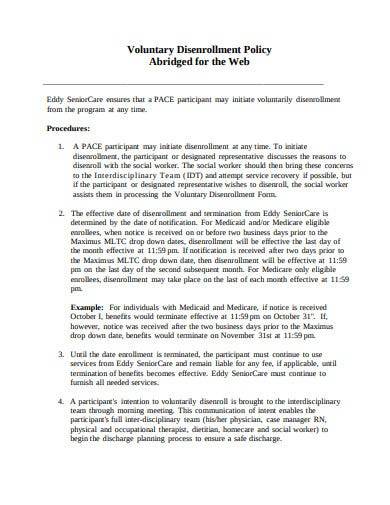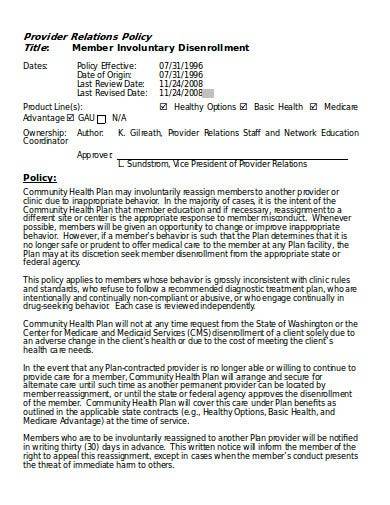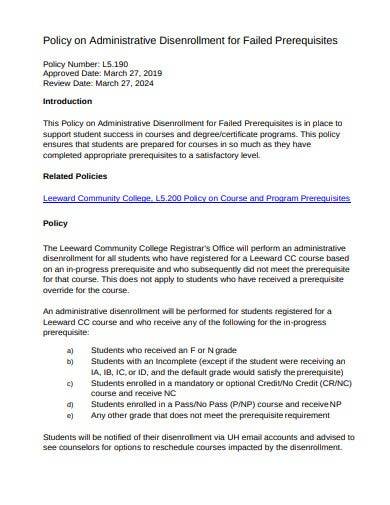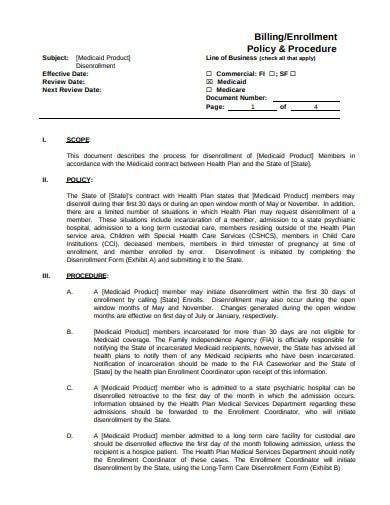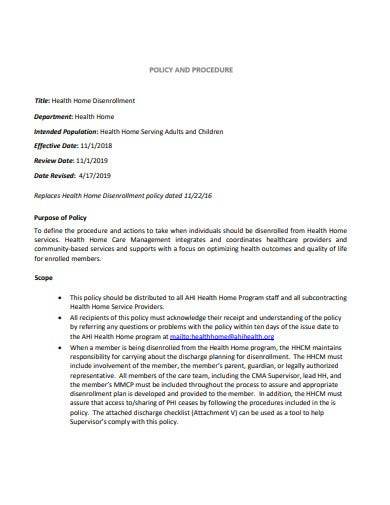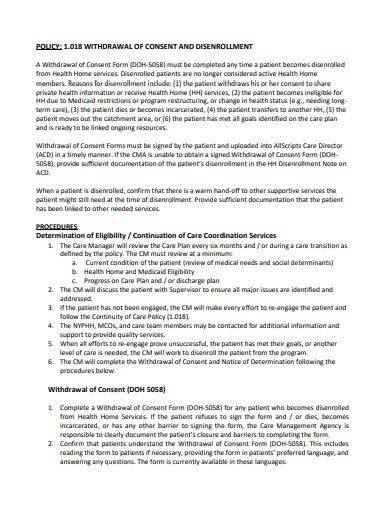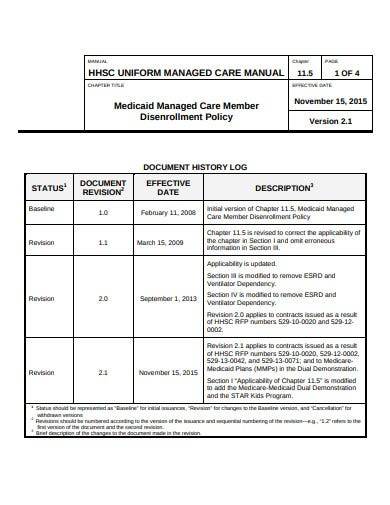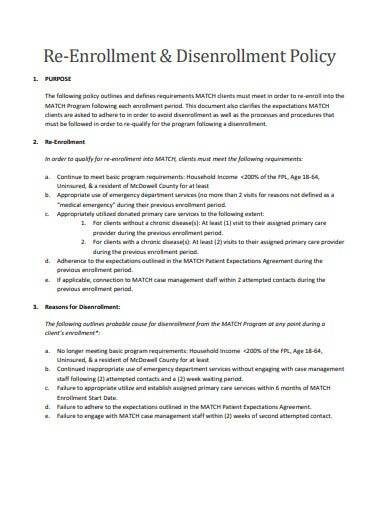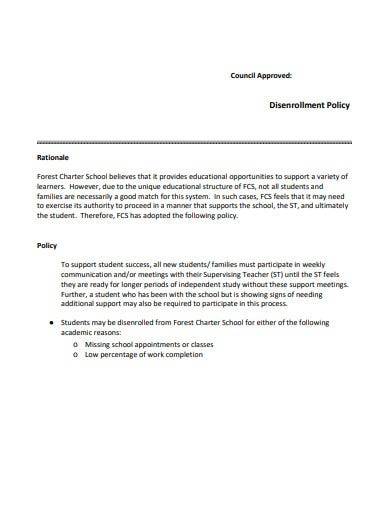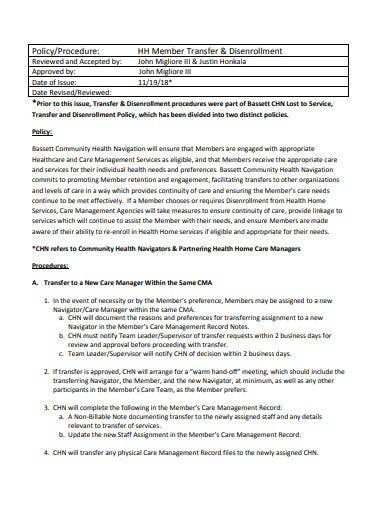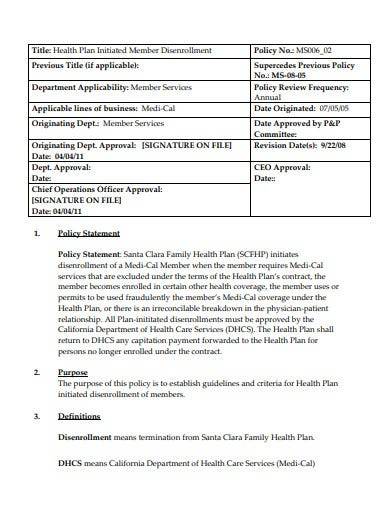Every day, organizations and companies receive new membership enrollments and registrations. However, it’s also not a surprise when there are a few who will want to back out and terminate their membership application samples or involvement even when they are already enrolled. So, what would be the best document to use for informing everyone about the rules and regulations of backing out from the enrollment list samples? A disenrollment policy, of course! It is the best option for organizations, especially those with healthcare plan and volunteer service industries.
FREE 10+ Disenrollment Policy Samples
1. Sample Voluntary Disenrollment Policy
2. Involuntary Disenrollment Policy Template
3. Sample Administrative Disenrollment Policy
4. Disenrollment Billing Policy Procedure
5. Disenrollment Policy & Procedure Template
6. Withdrawal of Consent Disenrollment Policy
7. Sample Member Disenrollment Policy
8. Re-Enrollment & Disenrollment Policy Template
9. Sample Disenrollment Policy Template
10. Member Transfer & Disenrollment Policy
11. Formal Member Disenrollment Policy
What Is a Disenrollment Policy?
A disenrollment policy contains the rules and regulations of an organization about how an enrolled member can disenroll. It will also state details and explanations of the disenrollment along with the necessary requirements to fulfill and submit, and the names and contact information of people to reach out in the organization. Also, some disenrollment policies will include the list of other options that the member can take as he disenrolls from the current membership, account, or list.
How to Make a Disenrollment Policy
Anthem Blue Cross’s disenrollment policy stated that when a member disenrolls from a health plan, he will proceed to receive Medicare and Medi-Cal plans in separate services as opposed to the combined and previously enrolled plan. On the one hand, other providers require their enrolled members to take up one plan after the disenrollment. But, regardless of the plans and offers presented, organizations should provide enough explanations and details in the policy samples. So, keep the following tips in mind when you decide to start establishing your organization’s disenrollment policy:
Step 1-Define Disenrollment
There are many ways to take away one’s enrollment offers, plans, data, and membership. The most common include a membership or registration cancellation, termination, revocation, and the disenrollment option. And each of the above-mentioned terms have varying meanings, so make sure that you define the term “disenrollment” in the policy. You can state the definition as part of the introduction narrative or in the first paragraph of the policy.
Step 2- List Eligibility and Disenrollment Requirements
Of course, not everyone is eligible to file for disenrollment, so you should indicate in the policy who can file and request. Also, don’t forget to include the particular legal forms, documents, and every paperwork or proof that you want the requesting member or enrolled to submit for his disenrollment.
Step 3-State How-Tos
How-tos are meant for placing step-by-step instructions and guidelines that will help your target readers process their disenrollment requests. Therefore, make sure that your how-tos are detailed and complete with every step that the requestor or reader will follow. You can also opt to add tips and the list of contact persons to reach out for requesting the disenrollment.
Step 4- Monitor and Evaluate Policy
Regularly review the disenrollment policy to ensure it is achieving its intended purpose and making necessary adjustments if needed. If necessary, consult with legal experts to ensure that your disenrollment policy is compliant with relevant laws and regulations.
Why might someone be disenrolled from a program or organization?
There are various reasons why someone might be disenrolled, such as failure to meet requirements, violation of policies or rules, or other grounds for disenrollment.
Who is responsible for initiating and carrying out the disenrollment process?
The responsible parties should be clearly identified in the policy. This may include program staff, administrators, or an independent review board.
Can someone appeal their disenrollment?
The policy should specify whether there is an opportunity to appeal the disenrollment decision and the process for doing so.
Many programs and organizations are required by law or regulation to have a disenrollment policy. A well-designed policy can help ensure that the organization is in compliance with these requirements.
Related Posts
FREE 15+ Construction Safety Policy Samples in MS Word | Google Docs | PDF
FREE 20+ Student Feedback Policy Samples in PDF
FREE 30+ Fee Policy Samples in PDF | MS Word
FREE 29+ Work Policy Samples in PDF
FREE 20+ Recruitment Policy Samples in PDF
FREE 20+ Policies and Procedures Samples in MS Word | Google Docs | PDF
FREE 50+ Feedback Policy Samples in PDF | MS Word
FREE 10+ High School Credit Policy Samples & Templates in MS Word | PDF
FREE 10+ Student Freedom of Expression Policy Samples in PDF
FREE 10+ Suicide Prevention Policy Samples in MS Word | PDF
FREE 10+ Plagiarism/Cheating Policy Samples in MS Word | PDF
FREE 50+ Policy Approval Samples in PDF | MS Word
FREE 50+ Planning Policy Samples in MS Word | Google Docs | Pages | PDF
FREE 10+ Related Personnel Policy Samples in MS Word | PDF
FREE 10+ Suspension And Expulsion Policy Samples in MS Word | PDF

